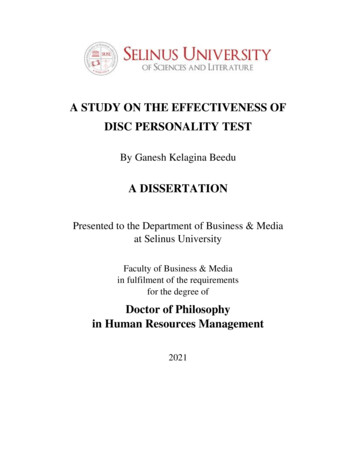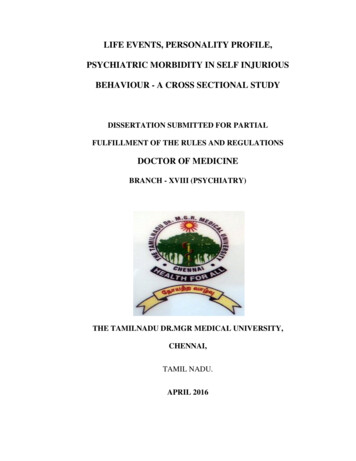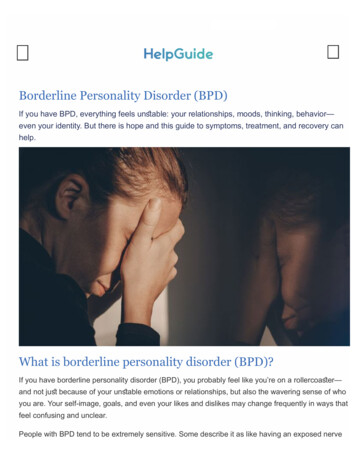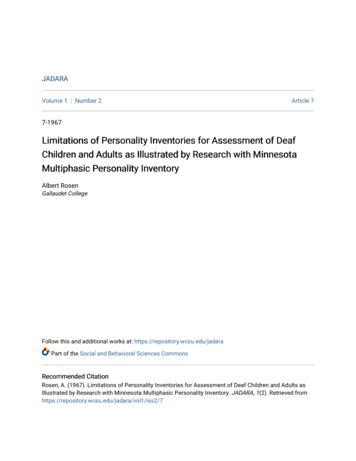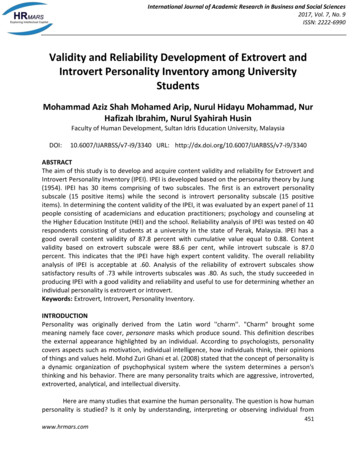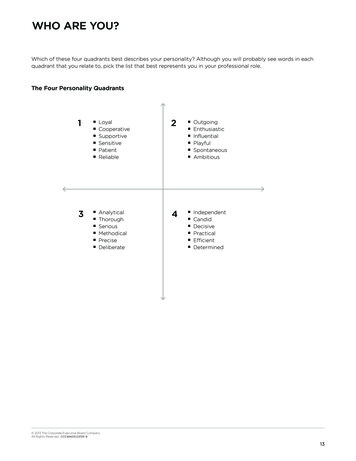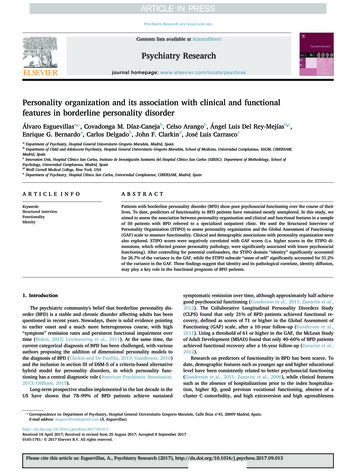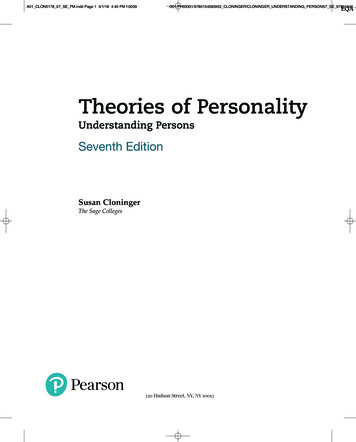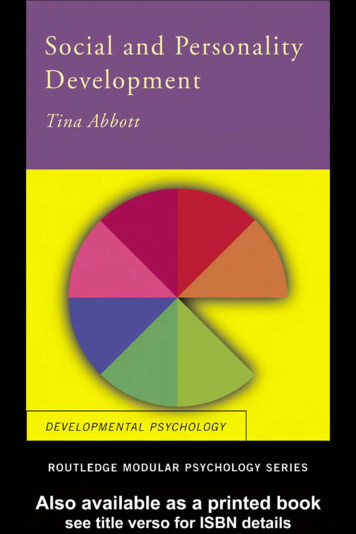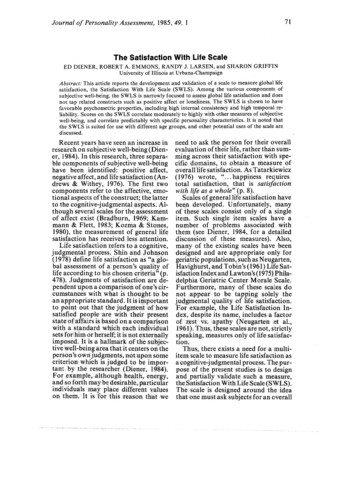
Transcription
Journal of Personality Assessment, 1985,49, 1The Satisfaction With Life ScaleED DIENER, ROBERT A. EMMONS, RANDY J. LAR.SEM, and SHARON GRIFFINUniversity of Illinois at Urbana-ChampaignAbstract: This article reports the development and validation of a scale to measure global lifesatisfaction, the Satisfaction With Life Scale (SWLS). Among the various components ofsubjective well-being, the SWLS is narrowly focused to assess global life satisfaction and doesniot tap related constructs such as positive affect or loneliness. The SWLS is shown to havefavorable psychometric properties, including high internal consistency and high temporal reliability. Scores on the SWLS correlate moderately to highly with other measures of subjectivewell-being, and correlate predictably with specific personality characteristics. It is noted thatthe S W 1sS suited for use with different age groups, and other potential uses of the scale arediscussed.Recent years have seen an increase inresearch on subjective well-being (Diener, 1984). In this research, three separable components of subjective well-beinghave been identified: positive affect,negative affect, and life satisfaction (Andrews & Withey, 1976). The first twocompodents refer to the affective, emotional aspects of the construct; the latterto the cognitive-judgmental aspects, A1though several scales for the assessmentof affect exist (Bradburn, 1969; Kammann & Flett, 1983; Kozma & Stones,1980), the measurement of general lifesatisfaction has received less attention.Life satisfaction refers to a cognitive,judgmental process, Shin and Johnspn(19'78) define life satisfaction as "a global assessment of a person's quality oflife according to his chosen criteria" (p.478). Judgments of satisfaction are dependent upon a comparison of one's circumstances with what is thought to bean appropriate standard. It is importantto point out that the judgment of howsatisfied people are with their presentstate of affairs is based on a comparisonwith a standard which each individualsets for him or herself; it is not externallyimposed. It is a hallmark of the subjective well-being area that it centers on theperson's own judgments, not upon somecriterion which is jpdged to be importanr by the researcher (Dienes, 1984).For example, although health, energy,and so forth may be desirable, particularindividuals may place different valueson them. It is far this reason that iveneed to ask the person for their overallevaluation of their life, rather than summing across their satisfaction wit11 specific domains, to obtain a measure ofoverall life satisfaction. As Tatarkiewicz(1976) wrote, ". .happiness requirestotal satisfaction, that is satisfiictionwith life as a whole" (p. 8).Scales of general life satisfaction havebeen, developed. Unfortunately, manyof these scales consist only of a singleitem. Such single item scales have anumber of problems associated withthem (see Diener, 1984, for a detaileddiscussion of these measures). Also,many of the existing scales have beendesigned and are appropriate only forgeriatric populations, such as Neugarten,Havighurst, and Tobin's (1961) Life Satisfaction Index and LawtonYs(l975)Philadelphia Geriatric Center Morale Scale.Furthermore, many of these scalles donot appear to be tapping solely thejudgmental quality of life satisfaction.For example, the Life Satisfaction Index, despite its name, includes a factorof zest vs. apathy (Neugarten :t al.,1961). Thus, these scales are not, strictlyspeaking, measures only of life. saitisfaction,Thus, there exists a need for a ]multiitem scale to measure life satisfaction asa cognitive-judgmental process. The purpose of the present studies is to designand partially validate such a measure,the Satisfaction With Life Scale (SINLS).The scale is designed around the ideathat one mmt ask subjects for an oiverall
72judgment of their life in order to measure the concept of life satisfaction.Study 1In the initial phase of scale co.nstruction, a list of 48 self-re ortitems weregenerated. These consisied primarily ofquestions related to satisfaction withone's life; however, some positive andnegative affect items were included. Inrresulted in three facitial f a c t analysestors: pssitive affect, negative affect, andsatisfaction. The affect items were eliminated, as were items from the satisfaction factor that had loadings less than.60, and 10 items were left. Because ofthe high semantic similarity of several ofthose items, five were dropped, resultingin a five-item scale, the SWLS. Study 1was designed to te t the psychometricproperties of the scale.MethodSubjects were 176 undergraduates atthe University of Illinois who were enrolled in introductory psychology classes.Subjects were administered the SWLSin a group setting. Two months later, 76of these students were readministeredthe s'cale.ResultsThe mean score on the SWLS was23. , with a standard deviation of 6.43.Each itern is scored from 1 to 7, so thepossible range of scores on the questionnaire is from 5 (low satisfaction) to 35(high satisfaction). The two-month testretest correlation coefficient was .82,and coefficient alpha was .87. The interitern correlation matrix was factor anal y z dusing,principal axis factor analysis. The number of factors to be extracted was determined by an inspection ofthe scree plot of eigenvalues. Using thiscriterion, a single factor emerged, accounting for 66% of the variance. TheSWLB items and their respective factorloadjn s are presented in Table 1, alongwith the item-total correlation for eachitiem.Having shown that the SWLS has desirable psychometric properties, the nextstep was to examine the relationship be-The Satisfaction with Life ScaleTable lSWLS Items and Factor LoadingsItem1. In most ways my life isclose to my ideal.2. The conditions of my lifeare excellent.3. Ia m satisfied with my life4. S o far I have gotten the important things I want inlife.5. If Icould live my life over,I would change almostnothing.ItemFactor TotalLoadings Correlations.84.75.77.83.69.75.72.67.61.57Note: n 176. SWLS Satisfaction With LifeScale.Instructions for administering the scale are: Below are five statements with which you may agreeor disagree. Using the 1-7 scale below, indicateyour agreement with each item by placing the appropriate number on the line preceding that item.Please be open and honest in your responding.The 7-point scale is: 1 strongly disagree, 2 disagree, 3 slightly disagree, 4 neither agree nordisagree, 5 slightly agree, 6 agree, 7 stronglyagree.tween it and other measures of subjective well-being, and also with certainpersonality measures to which we mightexpect it to be related.MethodTwo different samples of undergraduates served as subjects. Sample 1 consisted of the 176 students used in Study1. Sample 2 consisted of a differentgroup of 163 undergraduates enrolled inintroductory psychology classes. In addition to the SWLS, subjects were alsoadministered a battery of subjective wellbein measures. These included: Cantril's(1968 elf-Anchoring Ladder, Gurin eta1.L (1960) widely used item, Andrewsand Withey's (1976) D-T scale, and Fordyce's (1978) single item measure ofhappiness, Fordyce's (1978) percent oftime happy question, Campbell, Converse, and Rodgers'(1976) semantic differential-like scale, Bradburn's (1969)Affect Balance Scale, Tellegen's (1979)
E. DIENER, R. A. EMMONS, R. J. LARSEN, and S. GRIFFINTable 2Correlations Between the S W L S a n dOther Meas rresof Subiective Well-BeingSample 1 Sample 2( n 176) ( n 163)Fordyce 1Fordyce (percent)DPQCantrilGurimAndrews and WitheyCampbellBradburn-PASBradburn-NASSum medDomain Satisf.AIMNote: DPQ Differential Personality Questionnaire. PAS Positive Affect Scale. NAS Negative Affect Scale. AIM Affect IntensityMeasure. Sample 2 was not administered theDPQ or the AIM, and Sample 1 did not completethe domain satisfaction items.-well-being subscale of his DifferentialPersonality Questionnaire, and Larsen's(1983) Affect Intensity Measure (AIM).Sample 2 was also given Buss and Plomin's (1975) survey of the temperaments(EASI-111), the Rosenberg (1965) SelfEsteem Scale, the Neuroticism scale ofthe Eysenck IPersonality Inventory (Eysenck & Eysenck, 1964), a symptomchecklist similar to the Hopkins inventory (Derogatis, Lipman, Rickels, &Plomin, 1974), ratings of life satisfaction in 10 key life domains (e,g., grades,health, love life, and friends), and theMarlowe-Crowne (Crowne & Marlowe,1964) scale of social desirability. The 10life domain questions simply asked subjects to rate each of these areas of theirlife. These ral.ings were then summqd inan unweighted way to yield a domainsatisfaction c ompositescore.ResultsScores on the SWLS correlated .02with the Marlowe-Crowne measure, indicating that the SWLS is not evoking asocial desirability response set. The correlations between the SWLS and theother measures of subjective well-being73are shown in Table 2.In both samples there are moderatelystrong correlations with all of the subjective well-being scales except the AIM,which is a measure of the intensity ofemotional experience. The correlationsfor Sample 2 between scores 011 theSWLS and scares on the selected1 personality measures were self-esteem ,.54;symptom checklist, -.41; neuroticism,-.48; emotionality, -.25; activity, .08;sociability, 20; and impulsivity, -.03. Itappears that individuals who are satisfied with their lives are in general welladjusted and free from psychopatho logy.Study 3Both studies above were: limited tocollege student populations. I n the present study we assessed the psychometricproperties of the SWLS on a geriatricpopulation. In addition, we obtained acriterion validity coefficient for the S WLSin terms of a life satisfaction rating ]madeby experimenters who interviewed eachsubject about their life.MethodFifty-three elderly persons living inthe Urbana-Champaign area voluntiseredfor the project. There were four nnajorgroups of subjects: those in a nursinghome, shut-ins, a coffee-group of formerbusinessmen, and a group of religiouslyoriented women who met together periodically. The average age was 75, and 32were females. Each participant was interviewed about their life for about onehour by a pair af trained interviewers.Subjects received a structured set ofquestions which focused on .theextent towhich they remained active and wereoriented toward self-directed learming.At the end of the session, subjects completed a large print version of the SjWLSand a revision of the Life SatisfactionIndex (Adams, 1969). The interviewersindependently rated each subject in tlermsof glabal life satisfaction on a 7-pointscale.ResultsThe mean SWLS score for the samplewas 25.8. The ratings of the two inter-
74viewers correlated .73 and were summedto create a rater life satisfaction composite judgment. This value correlated .43with the SWLS. The LSI and the SWLScorrelated -46 and the LSI and interviewer composite correlated .68. Theitem-total correlations for the five SWLSitems were: 3 1 , .63, .61, .75, and .66,again showing a good level of internalconsistency for the scale.DiscussionThe results indicated that the scalehas favorable psychometric properties.The correlations with ersonalitvindicators of well-being disiussed in study 2suggest that the scale might be useful inclinical 'seittin@*The correlation of .57with summed domain satisfactions indicates that global satisfaction and domain satisfactions share a good deal ofcommon vari nce,but certainly are notequivalent constructs. The SWLS correlated at an adequate level with interviewer estirnhtas of life: satisfaction. Aquestion arises about why the interviewer ratings correlated mlore highly withthe LSI than with the SWLS. The LSI isa broader bandfinstrumentthat includesaffe tiveas weXl I; life eatisfaction content. It appears that the interviewer ratings wen also influendad by such affective cbnteat and thus correlated morehighly uiiiieb, thB LSI. The narrow bandcharacteir af eha SWLS is supported bythe firrdfpp of Laraem, Diener, aadEmrnansi 1(1,9 3 1rwhich showed that theSWL%showad weaker orr relations witha f f e thphtdid ather measures of subjective we1lkbe;ing.Future zpslaprch needs t o establish thediscriminlant validity of the scale, andshould &\soexplore in more depth therelationship between affect and life satisfactibn, as well as the relationship between,life 'rllaYPsfactionand domain satisfqctiads. M'nlikd other scales, the SWLSleave tip r spondentfree to weightvariaps djbr l@i;llns(e.g., heialth or materialwealth) and various feeling states (e,g.,loneliness) in whatever way he or shechooses.The Satisfaction with Life ScaleReferencesAdams, D. L. (1969). Analysis of a life satisfactionindex. Journal of Gerontology, 24, 470-474.Andrews, F. M., & Withey, S. B. (1976). Socialindicators of well-being: America's perceptionof life quality. New York: Plenum.Bradburn, N. M. (1969). The structure ofpsychological well-being. Chicago: Aldine.Buss, A. H., & Plomin, R. (1975). A temperamenttheory of personality development. New York:Wiley .Campbell, A., Converse, P. E., & Rodgers, W. L.(1976). The quality of American life. NewYork:Russell Sage.Cantril, H. (1965). Thepatterns ofhuman concern.New Brunswick, NJ: Rutgers University Press.Crowne, D. P., & Marlowe, D. (1964). Theapproval motive. New York: Wiley.Derogatis, L. R., Lipman, R. S., Rickels, J., &Covi, L. (1974). The Hopkins Symptom Checklist: A measure of primary symptom dimensions.In P. Pichot (Ed.), Psychological measurementsin psychopharmacology: Modern problems inpharmacopsychiatry. Basel, Switzerland: S.Kraeer."Diener, E. (1984). Subjective well-being. Psychological Bulletin, 95, 542-575.Eysenck, H. J.,& Eysenck, S. B. G. (1964). Manualof the' EysenckpersonalEty invenrory, San Diego,CA: Educational and Industrial Testing Service.Fordgce, M. W. (1978). Prospectus: The selfdescription inventory. Unpublished paper, Edison Community College, Ft. Myers, FL.Gurin, G.,Veroff, J., & Feld, S. (1960). American'sview of their mental health. New York: BasicBooks.Kaamann, R., & Flett, R. (1983). Affectometer 2:A scale to measure current level of general happings . Australiah Journal of Psychology, 35,257-265.Ko kna,A., & Stones, M. J. (1980). Tqe measurement of hapdiness: Development ofthe MemorialUniversity of Newfoufldland Scale of Ha piness(MUNSCH). Journol of Gerontology, f5,906912.Larsen, R. J. (1983). Manual for the leffect Intensity Measure. Unpublished manuscript, University of Illinois at Urbana-Champaign.Larsen, R. J., Diener,.E., & Emmons, R. A. (1983).Validity and meaning of measures af subjectivewell-being. Paper presented at the MidwesternPsychological Association Canvention, Chicago.Lawton, M. P. (1975). The Philadelphia GeriatricCenter Morale Scale: A revision. Journal ofGerontology. 30, 85-89.Neugarten, B. L., Havighurst, R. J., &Tobin, S. S.(19161). The measurement of life atisfaction.Journal of Gerontology, 16, 134-143.Rosqnberg, M. (1965). Society and the adolescentso&-image. Princeton, NJ: Princeton UniversityPress.
E. IDIENER, R. A. EMMONS, R. J. LARSEW, and S. GRIFFINShin, D. C., & Johnson, D. M. (1978). Avowedhappiness as an overall assessment of the qualityof life. Social Indicators Research, 5, 475-492.Tatarkiewicz, W. (1976). Analysis of-happiness.The Hague, Netherlands: Martinus Nijhoff.Tellegen, A. (1979). DSfferentialpersonaZityquestionnaire. Unpublished materials, University ofMinnesota.Ed DienerDepartment of PsychologyUniversity of Illinois603 E. DanielChampaigll9 IL 61820 d y" '; ,2' 19"
Life satisfaction refers to a cognitive, many of the existing scales have been judgmental process, Shin and Johnspn designed and are appropriate only for . Please be open and honest in your responding. The 7-
